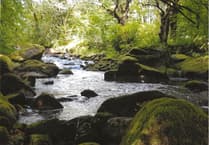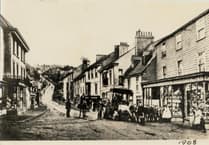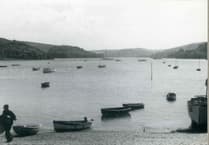Members of the public and armed forces came together in rainy Torcross on Sunday to mark the 73rd anniversary of Exercise Tiger.
This year, the annual memorial service was held on Sunday, April 30, at the Sherman Tank Memorial Site, Torcross, and was organised by the Royal Tank Regiment Association.
Graham Jinks, South Milton, was a member of the dive team that laid brass plaques and the stars and stripes on both wrecks, and attended the service on Sunday. He said: “Another great turnout for the 73rd anniversary of Exercise Tiger, attended by Dean and Sarah Small - Dean is the son of Ken Small who found the tank that now sits at Torcross - and also Laurie Bolton from America, who’s uncle was lost on the LSTs, along with service men from the Royal tank regiment.
“Wreaths were laid by Dean and Sarah and Laurie Bolton, and other armed services, also on behalf SaeTec Divers who had laid brass plaques and the ‘stars and stripes’ on both wrecks in the past.”
Exercise Tiger was a Second World War training exercise that took place off the cost of Torcross and Slapton that claimed the lives of 639 American servicemen.
The similarity between the Start Bay area and the Normandy coast prompted the use of the area for several full-scale and live ammunition battle exercises. Slapton Sands was thought to be a perfect place for the Exercise Tiger operation to simulate practice landings for Utah Beach, France, as part of Operation Overlord on June 6, 1944.
In the early morning hours of April 28, 1944, eight Landing Ship Tanks or LSTs, full of American servicemen and military equipment were converging in Lyme Bay, off the coast of Devon, England, making their way towards Slapton Sands for the D-Day rehearsal, ‘Exercise Tiger’.
A group of four German E-Boats, alerted by heavy radio traffic in Lyme Bay, intercepted the three-mile long convoy of vessels.
The heavily laden, slow moving LST’s were easy targets for the torpedo boats which first attacked the unprotected rear of the convoy.
A series of tragedies, including the absence of a British Navy destroyer assigned as an escort having been ordered into port for repairs, and an error in radio frequencies, led to three of the LST’s being hit by German torpedoes.
More loss of life was caused by life jackets being incorrectly worn by Army personnel and the extreme cold of the sea resulting in hypothermia. As a result, 639 American soldiers and sailors died in the early morning hours of Exercise Tiger.
The loss of life was greater than that later suffered by the assault troops during the initial attack on Utah Beach.




